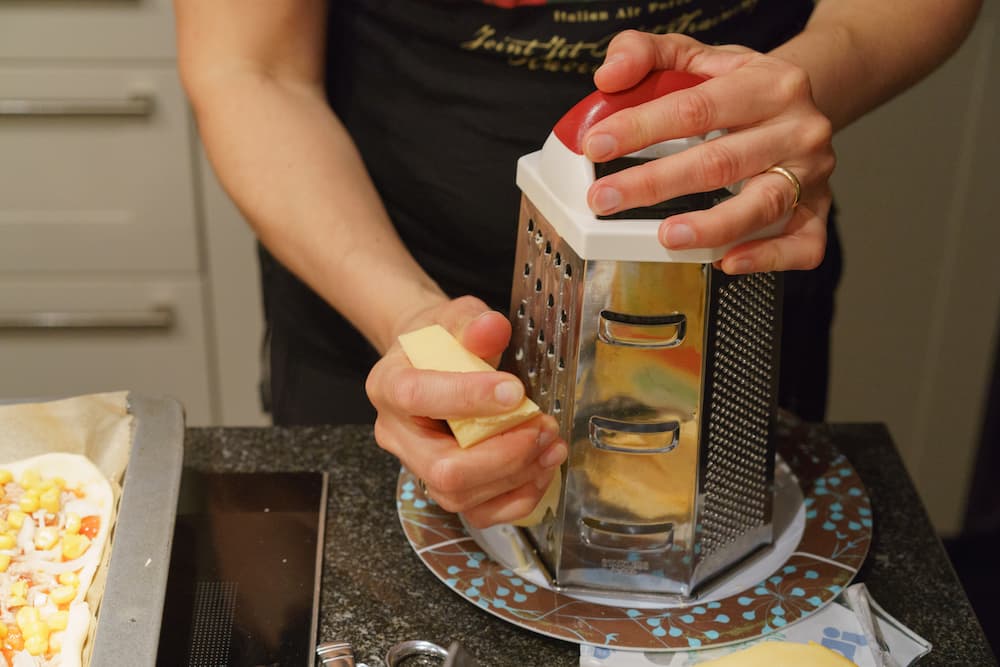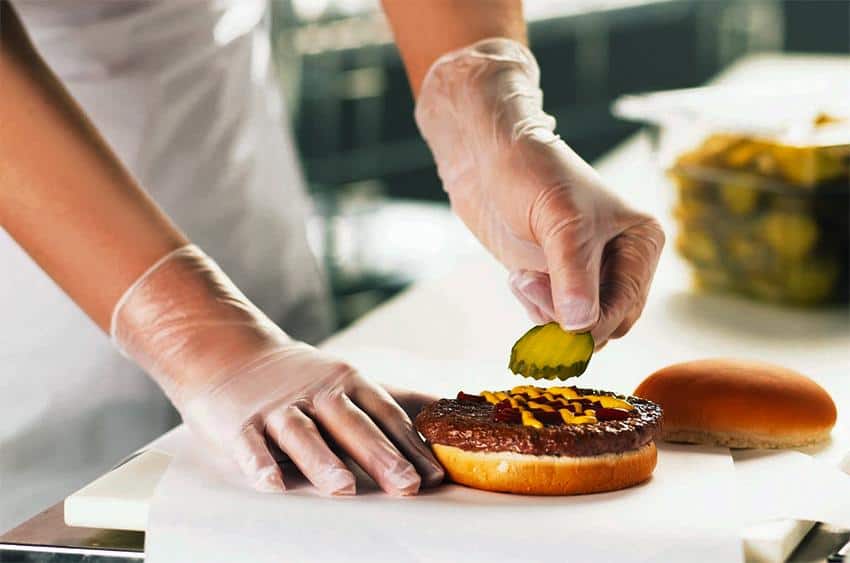
Jewelrymay be a beautiful accessory, but it can also become a significant food safety risk. In foodservice environments, where cleanliness and hygiene are paramount, the presence of jewelry on workers' hands and wrists can pose multiple hazards, from bacterial contamination to physical injury.
While many foodservice workers might be unaware of these risks, understanding the importance of jewelry hygienecan help prevent serious issues, from foodborne illnesses to customer harm.
In this article, we'll explore the risks jewelry can pose in foodservice settings, outline the FDA’s jewelry guidelines for food handlers, and provide practical tips for employers and employees to ensure food safety while maintaining necessary hygiene standards.
Why Jewelry Can Be A Food Safety Nightmare
Jewelry, especially rings, bracelets, and watches, can harbor harmful pathogens, making it a significant concern in food preparation areas. These items come into constant contact with the skin, other surfaces, and food, acting as reservoirs for germs.
Dead skin cells, oils, food particles, and bacteria can accumulate on jewelry, creating an environment ripe for contamination.
Common Hazards:
- Bacterial Growth: Jewelry acts as a breeding ground for bacteria, which can easily transfer to food or utensils.
- Physical Risks: Jewelry can get caught in machinery, or items like rings can break off and end up in food, posing a choking hazardor causing cuts.
- Increased Cleaning Challenges: Jewelry often has intricate designsand grooves, which can trap dirt and bacteria. Even diligent handwashing won't always reach these hard-to-clean areas.
By simply wearing jewelry, workers unintentionally increase the risk of contaminating the food they prepare or serve, making food safety protocols critical.
FDA Jewelry Guidelines For Foodservice Workers
The FDA Food Codeprovides specific guidelines to minimize jewelry-related contamination in foodservice environments. The primary goal is to ensure that germs do not transferfrom jewelry to food. Here's a breakdown of the FDA's recommendations:
Do's:
- Plain, Smooth Rings: Foodservice workers are allowed to wear plain wedding bandswithout grooves where bacteria can hide.
- Regular Hand Washing: Frequent handwashing is a must, particularly after touching jewelry or anything that might carry pathogens.
- Use Gloves: If you wear a ring, gloves are necessary to prevent cross-contamination.
Don'ts:
- No Watches, Bracelets, or Rings with Stones: Rings with jagged edges, watches, bracelets, and necklacesare strictly prohibitedas they can harbor germs and complicate proper cleaning.
- No Facial Jewelry: Earringsand facial jewelry may be allowed, but their potential to contaminate food makes them risky.
Food service managers should implement clear policies regarding jewelry, ensuring compliance with the FDA guidelinesand maintaining a hygienic environment.
Related: The Use Of Gemstones In Sustainable And Organic Farming - A Greener Approach
5 Risks Of Wearing Jewelry While Handling Food
Jewelry can introduce several hazards in foodservice settings. Here are the top five risks of wearing jewelry while working with food:
1. Germs Accumulation
Jewelry tends to collect bacteria and pathogens. From constantly adjusting rings to touching doorknobs or phones, your jewelry comes into contact with countless surfaces. Without regular cleaning, these germs can be transferred to food, creating a significant foodborne illness risk.
2. Tears In Gloves
Rings with sharp edges or large, bulky bracelets can tear through gloves, causing them to become ineffective at blocking contamination. If gloves tear, they must be changed immediately, which could delay service and increase the risk of contamination.
3. Cross-Contamination
Even with gloves, jewelry can still introduce contaminants to the food. If workers forget to remove jewelry before handling food, germs from the jewelry can be transferred. Furthermore, intricate jewelry designs are difficult to clean thoroughly, meaning food can come into contact with harmful bacteria that’s trapped in small nooks and crannies.
4. Physical Hazards
Rings, bracelets, or watches that fall into food can cause injuries. A customer could choke on a piece of jewelry or suffer a cut. Furthermore, jewelry can get caught in machinery, which could injure the worker.
5. Decreased Handwashing Effectiveness
Jewelry can interfere with thorough handwashing. If a worker leaves their jewelry on during handwashing, germs can hide under the pieces, escaping proper sanitization. Taking the jewelry off before washing hands increases the risk of re-contamination when it’s put back on.
Employer’s Role In Preventing Jewelry Contamination
Employers play a crucial role in ensuring food safetyand minimizing the risk of jewelry contamination. Here’s how businesses can implement effective policies:
1. Establish Jewelry Policies
Employers should create clear, written jewelry policiesfor all staff members. This includes guidelines for acceptable jewelry and required hygiene practices. The policies should also address specific concerns like medical alert jewelryand provide reasonable accommodationsfor employees who need to wear it.
2. Provide Training
Regular training sessions on the FDA jewelry regulationsand the risks of contamination can help foodservice workers understand the importance of proper hygiene. Employers should emphasize that jewelry should be stored away and only plain, smooth rings should be worn.
3. Regular Monitoring
Managers should monitor compliance with jewelry policies and ensure workers are adhering to hygiene standards. Random checks or routine audits can help identify issues early.
4. Consider Alternative Jewelry For Medical Needs
For employees who need medical alert bracelets, consider alternatives like a necklaceor anklet. Discuss alternatives with the employee to accommodate their medical needs while still ensuring food safety.
Consequences Of Violating Jewelry Regulations In Foodservice
The consequences of not adhering to jewelry hygiene standards can be severe, both for the businessand its customers. Here’s what could happen:
1. Health Code Violations
If foodborne illnesses occur due to contamination from jewelry, businesses can face health code violations. These violations can lead to fines, legal actions, or even closure of the establishment.
2. Legal Ramifications
Failure to comply with FDA regulationsor local food safety standards can lead to costly legal consequences. Foodservice businesses must prioritize customer safety to avoid lawsuits or reputational damage.
3. Reputational Damage
Newsof contamination due to jewelry mishandlingcan spread quickly, damaging the business's reputation. Customers may choose not to return if they feel unsafe.
Best Practices For Jewelry Safety In Foodservice
Here are the best practicesfor jewelry safety in foodservice to help businesses and employees maintain a hygienic environment:
- Leave Jewelry at Home: The easiest way to prevent contamination is not to wear jewelry at all. This minimizes the risk of foodborne illness and physical hazards.
- Use Plain Rings Only: If wearing a ring is necessary, make sure it’s plain and smooth, without intricate designs or stones.
- Wash Hands Regularly: Regular handwashing is essential, and jewelry should be removed during this process to ensure thorough cleaning.
- Wear Gloves: Gloves should always be worn when handling food, and workers should ensure their gloves are intact and free of holes.
Quick Tips For Safe Jewelry Practices In Foodservice
To quickly implement safe jewelry practices, follow these steps:
- Store Jewelry Safely: Leave all jewelry at home before your shift begins.
- Use Alternatives for Medical Jewelry: Work with your manager to find acceptable alternatives to bracelets or necklaces that may pose a contamination risk.
- Maintain Hygiene: Wash hands thoroughly and change gloves regularly to reduce contamination risks.
- Follow Workplace Policies: Ensure you’re familiar with and follow all jewelry policies established by your employer.
FAQs
Can I Wear A Plain Ring While Working With Food?
Yes, according to FDA guidelines, a smooth, plain wedding band is allowed. However, any rings with grooves or stones should be avoided.
What Happens If I Forget To Remove My Jewelry While Preparing Food?
If you realize you’ve forgotten to remove your jewelry, stop working immediately, discard any contaminated food, and sanitize the work area.
Can I Wear A Medical Alert Bracelet While Working With Food?
While the FDA prohibits medical alert bracelets, alternative options like a necklace or anklet can be worn, in consultation with your employer.
Why Is Jewelry Such A Risk In Foodservice?
Jewelry collects germs, can tear gloves, and may fall into food, posing a significant contamination risk.
What Should Employers Do To Ensure Jewelry Safety?
Employers should establish clear jewelry policies, train employees, and enforce proper hygiene practices to prevent contamination.
Conclusion
Jewelry in foodservice environments can pose serious risks to both food safety and customer well-being. By following FDA guidelines, enforcing jewelry policies, and maintaining strict hygiene practices, businesses can minimize these risks.
For both workers and employers, understanding the potential dangers of wearing jewelry while handling food is crucial to ensuring a safe and sanitary environment.
Take action todayby reviewing your jewelry policies, training employees, and promoting proper hygiene practices. Preventing contamination begins with education and awareness, so be sure to lead by example.
You Might Like: Crystals For Weight Loss - How They Can Improve Your Diet & Exercise Game


